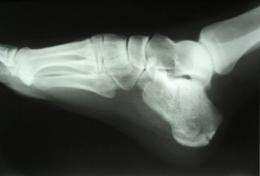February 7, 2011 report
Early humans won at running; Neandertals won at walking

(PhysOrg.com) -- New research has compared the performance of the heels of modern-day distance runners to the heels of Neandertals and ancient Homo sapiens. The results show the Neandertals' heels were taller than those of modern humans and Homo sapiens, and more adapted to walking than running over long distances, while those of Homo sapiens were more adapted to endurance running.
Assistant Professor of Anthropology, Dr David Raichlen of the University of Arizona in Tucson, and colleagues, found that unlike modern humans, the Neandertal heel was taller would have provided less spring during running, and speculated that the heel probably stabilized the ankle and helped in jumping and walking uphill. In modern humans the heel is lower and stretches the Achilles tendon and increases its ability to act like a spring and reduce the consumption of energy.
Dr Raichlen and colleagues had eight distance runners run on a treadmill at 10 mph (16 km/h) for periods of 10 minutes and calculated their rates of oxygen consumption. In different running periods, they also took magnetic resonance imaging (MRI) scans of their heels and Achilles tendons.
The results showed the heel bones were shorter and lower in the runners whose oxygen consumption while running was most efficient.
The heel measurements were compared with those of 13 fossil Homo sapiens dated from 30-100,000 years ago and with six Neandertals from around the same period. The researchers’ calculations suggest that during running the Homo sapiens would have expended 6.9% more energy than modern distance runners, but Neandertals would have needed an average of about 11.4% more energy.
The results suggest that while Neandertals may not have fared well in long-distance marathons, their bone structures would have given them an advantage in walking and in activities requiring great strength.
The results of the research support earlier findings that long-distance running in Homo sapiens evolved over two million years ago and probably helped early humans in hunting before spears began to be widely used about 400,000 years ago. The ability to run long distances in hot environments is thought to help in running prey to exhaustion. Neandertals lived in colder climates and probably needed different skills in hunting.
The paper was published in the Journal of Human Evolution.
More information: Calcaneus length determines running economy: Implications for endurance running performance in modern humans and Neandertals, by David A. Raichlen et al., Journal of Human Evolution, Article in Press, doi:10.1016/j.jhevol.2010.11.002
© 2010 PhysOrg.com

















